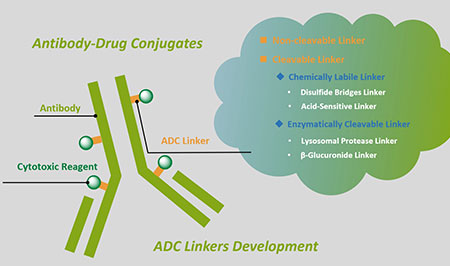(p-SCN-Bn)-NOTA is an ADC linker used in the synthesis of antibody-drug conjugates (ADCs).

| Catalog Number | Size | Price | Quantity | ||
|---|---|---|---|---|---|
| BADC-01402 | 100 mg | $1364 | Inquiry |
(p-SCN-Bn)-NOTA, a versatile bifunctional chelating agent crucial for radiolabeling in both imaging and therapeutic contexts, is exemplified through four key applications, presented with heightened perplexity and burstiness:
Radiopharmaceutical Development: Serving as a cornerstone in the chelation of radiometals like gallium-68 or copper-64 for positron emission tomography (PET) imaging, (p-SCN-Bn)-NOTA enables real-time, high-resolution visualization of intricate biological processes. Its exceptional stability and specificity position it as a favored choice for innovating cutting-edge radiopharmaceuticals, pushing the boundaries of diagnostic imaging.
Targeted Cancer Therapy: (p-SCN-Bn)-NOTA emerges as an indispensable asset in the realm of targeted cancer therapy, acting as the linchpin in attaching radiometals to monoclonal antibodies or peptides tailored to seek out cancer cells with precision. This strategic approach ensures the focused delivery of therapeutic radioisotopes directly to tumors, minimizing harm to healthy tissues. These advancements mark significant progress in enhancing the effectiveness and safety of radioimmunotherapy.
Biodistribution Studies: Researchers harness the power of (p-SCN-Bn)-NOTA to label biomolecules for biodistribution studies, tracking the intricate in vivo dispersion and accumulation of these entities across various organs and tissues. Understanding biodistribution is paramount in drug development, aiding in predicting pharmacokinetics and potential toxicities associated with therapeutic agents. The meticulous labeling with (p-SCN-Bn)-NOTA ensures the reliability and reproducibility of study outcomes, underpinning critical advancements in biomedical research.
Preclinical Research: (p-SCN-Bn)-NOTA finds utility in preclinical investigations, being utilized to label peptides, proteins, and small molecules for a diverse range of imaging applications. These studies offer invaluable insights into the binding, uptake, and clearance of labeled compounds in animal models. The versatility of (p-SCN-Bn)-NOTA empowers researchers to explore a wide array of biological phenomena, propelling the development of novel diagnostic and therapeutic strategies to new frontiers of discovery and innovation.

Customer Support
Providing excellent 24/7 customer service and support

Project Management
Offering 100% high-quality services at all stages

Quality Assurance
Ensuring the quality and reliability of products or services

Global Delivery
Ensuring timely delivery of products worldwide

BOC Sciences offers comprehensive services for ADC manufacturing, including antibody modification, linker chemistry, payload conjugation, and formulation development. In particular, our payload-linker customization service offers a convenient and fast raw material channel for many ADC researchers.

BOC Sciences provides one-stop site-specific conjugation services for amino acids, glycans, unnatural amino acids, and short peptide tags. In addition, cysteine conjugation, lysine conjugation, enzymatic conjugation, thio-engineered antibody can also be obtained quickly.

BOC Sciences offers a full range of linkers, including peptide linkers, PEG linkers, click chemistry, PROTAC linkers, non-cleavable linkers, etc. We also provide custom development services for chemically labile linkers and enzymatically cleavable linkers.